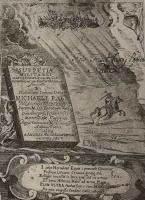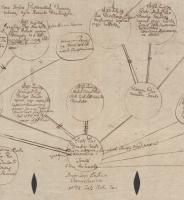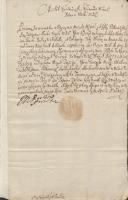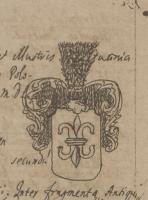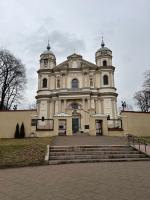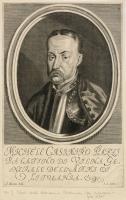Introduction
Dedicated to the celebration of the 400th anniversary of the birth of one of the most famous grand hetmans of the Grand Duchy of Lithuania – Mykolas Kazimieras Pacas (circa 1624–1682 April 4)
The fame of the Pacas family, like their double lily coat of arms, spread slowly. But when it was time for the lily to blossom, the history of the Grand Duchy of Lithuania, especially the city of Vilnius, blossomed accordingly. The family had created a myth about their Italian heritage, claiming to have relations with a Pazzi family from Florence. The Pacas family had been the kind of Lithuanian noblemen who, in the 15th century, would start a tradition of travelling to the eternal city – Rome. Only later, in the 16th century, such journeys would become a common part of the lifestyle of Lithuanian nobles. In the second half of the 17th century, three members of the Pacas family gained the most important secular and ecclesiastical offices in Lithuania: Kristupas Zigmantas became Chancellor (1658–1684), his brother Steponas became Bishop of Vilnius (1672–1684) and their cousin Mykolas Kazimieras became Grand Hetman of the Grand Duchy of Lithuania (1667–1682) and Voivode of Vilnius (1669–1682). The Pacas family were one of the most influential, rich and generous patrons of the 17th century who built catholic churches and established monasteries. One of the accomplishments of Steponas Pacas is the Church of Saint Teresa, an early baroque masterpiece in Vilnius near the Gate of Dawn. Kristupas Zigmantas Pacas gave to the Grand Duchy of Lithuania one of its pearls – the Pažaislis Monastery. There was a joke created about the Pacas family: people during the so-called Flood had been praying for peace – Pacis, Pacis – so much that they got the Pacas family rather than peace. However, the heritage of the Pacas family is no laughing matter. One of the most famous representatives of the Pacas family is Mykolas Kazimieras Pacas, whose personality deserves special attention.
Mykolas Kazimieras Pacas (about 1624–1682) hailed from one of the most influential families of the Grand Duchy of Lithuania – he was the son of Petras Pacas and his second wife Elžbieta Šemetaitė, and the brother of the Bishop of Samogitia, Kazimieras Pacas.
For what should we give thanks to Mykolas Kazimieras Pacas? To start with, for his victories in war and for one of the most beautiful monuments in Vilnius city – the Church of the Apostles St. Peter and St. Paul. This architectural gem of the city, dedicated to the Apostles St. Peter and St. Paul, transcends the times with its interior decoration, or so art historians claim. Its beauty has shone not only in Lithuania, but also in wider Europe.
The church was innovative in the context of Vilnius – it was the first brick church outside the wall of the city. Until then, only wooden churches had been built in the suburbs of the capital. The most brilliant idea of Mykolas Kazimieras Pacas was the interior décor of the new church. Pacas spent the same amount on the décor as on the construction. Not only is this church striking from the outside, the beauty of its interior is also timeless. According to Dr. Mindaugas Paknys, when admiring the three thousand white figures and figurines (no one has ever counted exactly how many of them decorate the walls, columns and vaults of the church), one should take into account at least a few things. Until then, the decoration with stucco had almost never been used in the Grand Duchy of Lithuania, so this idea of Mykolas Kazimieras Pacas had to surprise his contemporaries. Moreover, there were no architects in Lithuania who would be masters of this type of décor. Stucco (a mixture of gypsum and lime) is not a strong material, requiring special care. In the cold and damp climate of Lithuania, it does not harden easily. All this did not stop Mykolas Kazimieras Pacas from inviting two great sculptors from Italy – Giovanni Pietro Perti and Giovanni Maria Galli. They both spent eight years decorating the church (1676–1684). The Grand Duchy of Lithuania had not seen masters of such skill before. All researchers admit that there had been no other church in the territory of the Grand Duchy of Lithuania that could have had as many visual themes and scenes as the Church of the Apostles St. Peter and St. Paul in Vilnius.
But what kind of person was this prominent patron? He was not really connected to art in any way, having devoted his whole life to warfare. He was the Grand Hetman of the Grand Duchy of Lithuania. If we believe the testimony of his contemporaries, Mykolas Kazimieras Pacas had a straightforward character: he often had strong opinions and rarely changed his personal views. He was not inclined to diplomacy or compromise, but was famous in the Commonwealth as a dedicated, fair, and efficient military commander.
Mykolas Kazimieras Pacas took part in more than one military campaign and personally experienced the army’s flaws, which eventually led him to develop a plan to reform the army, introducing rules for army life and establishing procedure for military courts. He mounted efforts to defend his soldiers and protect their interests. During the North War of 1655–1660 (the Commonwealth against Sweden and Russia), he defeated the Swedish army several times in Curlandia in 1658–1659.
He was Army Camper of the Grand Duchy of Lithuania in 1659–1663, Field Hetman and Voivode of Smolensk in 1663–1667; from 1667, he was Grand Hetman and Castellan of Vilnius, as well as Voivode of Vilnius from 1669.
As often happens in history, due to great dedication to work (military affairs), the personal life of Mykolas Kazimieras Pacas suffered. He remained single until the end of his life, even though, for political reasons, his relatives and the king himself several times had offered him to wed some or other noble lady. According to Dr. Mindaugas Paknys, Mykolas Kazimieras Pacas lived rather luxuriously, as befits a rich nobleman. He had a palace (now Hotel PACAI) in the centre of Vilnius, right next to the Town Hall Square. Decorated by artists of the highest order, the palace fascinated his contemporaries with its grandeur. When King Jan Sobieski visited Vilnius (in 1686), he resided in this palace. As the research of Dr. Aušra Baniulytė shows, Mykolas Kazimieras Pacas liked to receive gifts, but he also liked to send gifts to others. The Grand Duke Kozim III of Tuscany offered him a devotional medallion and a valuable box, encrusted with precious stones, which was full of medicines for the hetman’s soldiers, as well as other gifts. Grand Hetman Mykolas Kazimieras Pacas did not remain in debt and in exchange presented the Grand Duke with a war trophy from battles with the Turks: a Turkish saddled horse from his own stable. Mykolas Kazimieras Pacas was also known to enjoy Italian food. A letter written on 28 April, 1679 to his trustee shows that Mykolas Kazimieras Pacas asks this trustee to provide him not only with horses, but also with two large chunks of parmesan cheese.
Mykolas Kazimieras Pacas was very pious and generously supported the Catholic Church, financing the printing of religious publications, the reconstruction of the Merkinė Church, supporting the Vilnius Jesuits and Bernardines, as well as various monasteries and churches. It is symbolic that he was buried quite modestly – in the entryway of the Church of the Apostles St. Peter and St. Paul in Vilnius. Here the nobleman is commemorated by a stone slab with an inscription: Hic jacet peccator (Here lies a sinner). Finally, in the 19th century, the generations of the Pacas family came to an end.
The unique legacy of Mykolas Kazimieras Pacas is preserved in the Wroblewski Library of the Lithuanian Academy of Sciences. In this virtual exhibition we introduce the most valuable exhibits that the library has to offer.

